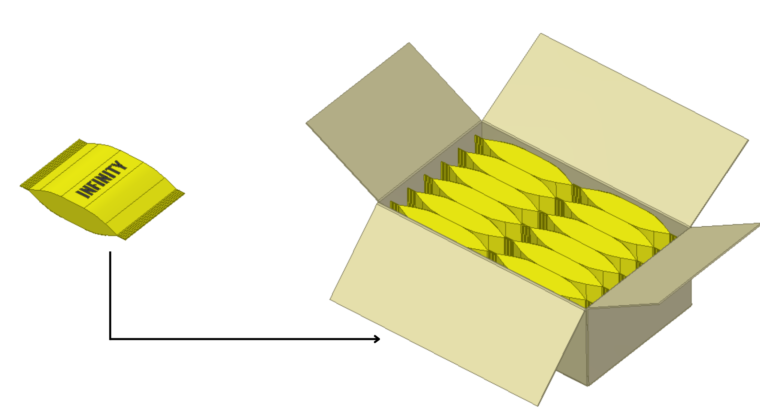Automatic case packing is a process in which products or items are automatically packed into cases or containers using specialized machinery. This process is commonly used in industries such as food and beverage, pharmaceuticals, consumer goods, and manufacturing.
Automatic Case Packing System
The automatic case packing system typically involves the following steps:
- Product feeding: The products are fed into the packing system, usually from a conveyor belt or another automated system. The products may be single items or pre-packaged in smaller units.
- Case forming: Empty cases or containers are formed from flat sheets or pre-made blanks. This is done using a case-forming machine that folds and seals the carton or container into the desired shape.
- Product grouping and orientation: Depending on the specific requirements, the products may need to be grouped or oriented in a particular manner before being packed. This step ensures efficient and consistent packing.
- Product loading: The products are loaded into the formed cases or containers. This is typically done using mechanical arms, robotic systems, or other automated mechanisms that carefully place the products in the designated positions within the case.
- Case sealing: Once the products are loaded, the cases or containers are sealed to secure the contents. This can be done through various methods such as adhesive tapes, hot melt glue, or mechanical closures.
- Case labeling and coding: Labels or codes can be applied to the cases for tracking, identification, and other purposes. Automated systems may integrate printing or labeling devices to add necessary information to the cases.
- Case handling and palletizing: After sealing and labeling, the cases are often conveyed to a palletizing area where they are arranged in specific patterns or configurations on pallets. This facilitates efficient transportation and storage.
The entire process is typically controlled by a central control system that coordinates the different components of the automatic case packing system. The machinery involved can vary depending on the industry and specific requirements, ranging from simple machines to complex robotic systems.
Automatic case packing offers several benefits, including increased packaging speed, improved accuracy, reduced labor costs, enhanced product protection, and consistent packaging quality. It can significantly streamline the packaging process and improve overall operational efficiency in various industries.
10 Reasons to Invest in Automatic Case Packing
Investing in automatic case packing offers several advantages for businesses across different industries. Here are ten reasons why it can be a worthwhile investment:
- Increased productivity: Automatic case packing systems can significantly increase packaging speed and efficiency compared to manual packing. This allows businesses to handle higher production volumes and meet customer demands more effectively.
- Cost savings: While the initial investment in automatic case packing machinery may be significant, it can lead to long-term cost savings. By automating the packaging process, businesses can reduce labor costs, minimize product damage, optimize material usage, and avoid expenses associated with manual errors.
- Improved packaging quality: Automatic case packing ensures consistent and precise packaging. It eliminates human error, such as improper stacking, incorrect product orientation, or inadequate sealing. This leads to improved packaging quality and reduces the risk of damaged or improperly packaged products.
- Enhanced product protection: Automatic case packing systems are designed to handle products with care, minimizing the risk of damage during the packaging process. They can incorporate features like gentle product handling, cushioning mechanisms, and precise stacking to ensure that items are well-protected within the cases.
- Efficient space utilization: Automatic case packing machines are designed to optimize space utilization within the cases or containers. They can arrange products in the most compact and efficient manner, reducing wasted space and enabling businesses to transport and store more products per shipment.
- Flexibility and adaptability: Automatic case packing systems can be configured to handle a wide range of product sizes, shapes, and packaging requirements. They offer flexibility in accommodating different product variations and can be easily adjusted to meet changing packaging needs.
- Enhanced traceability and tracking: Automatic case packing can integrate labeling and coding systems, allowing businesses to add essential information such as batch numbers, expiration dates, and barcodes to the cases. This facilitates traceability, improves inventory management, and enhances supply chain visibility.
- Improved workplace safety: By automating the packaging process, businesses can reduce manual labor and minimize the risk of injuries associated with repetitive tasks or heavy lifting. This creates a safer working environment for employees.
- Consistency and brand image: Automatic case packing ensures consistent packaging quality, which is essential for maintaining a strong brand image. Customers receive products that are uniformly packaged, leading to increased customer satisfaction and loyalty.
- Competitive advantage: Investing in automatic case packing can provide a significant competitive advantage in the market. It allows businesses to improve their operational efficiency, reduce costs, meet customer demands more effectively, and stay ahead of competitors who rely on manual packaging methods.
Overall, automatic case packing offers numerous benefits, including increased productivity, cost savings, improved packaging quality, enhanced product protection, and a competitive edge. It is a strategic investment that can positively impact the bottom line and contribute to long-term business success.


